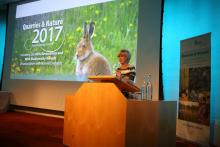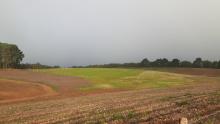
The UK mineral products industry is uniquely placed to deliver biodiversity net gain, with a track record of leaving wildlife in a better state than before development. That was the conclusion from the
MPA’s members manage or control an area of land of over 115 square miles; an area equivalent to a small National Park such as the Norfolk Broads. Further, the Mineral Products industry has created at least 8,300 ha of UK Priority Habitats and has restoration plans to deliver at least 10,700 ha in coming years. Between 2014-2017, over 34km of hedgerows have been planted.
The Quarries & Nature 2019 event attracted a capacity audience of over 70 leading environmental and conservation organisations and industry operators to celebrate the industry’s continuing contribution to nature conservation. It also explored how the industry can do even more to deliver net gain and showcased some of the best examples of quarry restoration and wildlife conservation anywhere in Europe.
Best practice was shared through the MPA Restoration Awards, now in their 49th year, and the MPA Biodiversity Awards in association with Natural England, and were presented by Dr Tony Juniper CBE, chair Natural England, Dr Carol Williams, director of Conservation, Bat Conservation Trust, Simon Marsh MBE, head of Nature Protection at RSPB and Dr Nick White, principal advisor, Net Gain, Natural England.
Presentations on net gain were given by expert speakers professor David Hill CBE, chairman of The Environment Bank, Tom Butterworth, technical director for Biodiversity at WSP and Kirsty Kirkham, partner of BSG Ecology. Dr Rob Simmons, associate professor in Sustainable Soil Management at Cranfield University, presented his work with Tarmac to trial new metrics to measure biodiversity net gain on quarries.
Commenting, MPA chief executive Nigel Jackson said: “By creating new habitats during quarry restoration, mineral products companies are uniquely placed to increase biodiversity and this year’s submissions and winners of our prestigious awards once again enrich and extend the legacy the industry has built over the decades. The mineral products industry is a pioneer in the field of nature conservation and is unrivalled by any other UK industry. Our achievements are not fully recognised by Government who consistently fail to appreciate how this industry can help them convert their aspirations for the natural environment into leadership and action on the ground. I hope that this year’s Quarries & Nature event triggers wider recognition and a new conversation with Defra in particular. We are very much part of the solution to the UK’s biodiversity challenges and are ready to play an even bigger role working with key stakeholders to protect and enhance UK biodiversity.”
The Cooper-Heyman Cup for outstanding restoration was jointly awarded this year to Aggregate Industries and Tarmac. Aggregate Industries work with Yorkshire Wildlife Trust, Middlemarch Environmental and Greenfields Countryside Ltd at Ripon City Quarry in North Yorkshire, has enabled a diverse mixture of priority habitats to be created, which the judges described as a well-researched and implemented scheme and a great asset to the area. Tarmac’s Broom Quarry, Bedfordshire is a former sand and gravel quarry that has been restored to a mixture of wildflower meadows, wetlands, woodland and farmland, which the judges described a ‘massive transformation’ on what was originally typical, uninteresting, agricultural land. The result is of great value to both the community and to wildlife.
In the Biodiversity Awards, the winner of the Landscape Scale category in association with Natural England was Aggregate Industries and RSPB for Venn Ottery Quarry, near Exeter, Devon - a 30-hectare sand and gravel site in the early stages of restoration predominantly to lowland heathland. The restoration involves partnership with RSPB with heathland and meadow creation, plus specific features including an orchard and bat roost. The connectivity of habitats both within the site and beyond into the surrounding countryside is particularly impressive, as the collaborative partnership with RSPB was strong, and involved local communities.
The overall winner of the Planned Biodiversity-led Restoration category was CEMEX and Northumberland Wildlife Trust ('Save our Magnificent Meadows' Initiative) for the Divethill Quarry Farm Extension Area, Capheaton, Newcastle Upon Tyne - a fantastic example of progressive restoration of a rock quarry to create an attractive landform and a mosaic of species-rich, locally important and distinctive ‘Whin’ grassland, agricultural grassland, woodland and hedges, and open water. The judges were impressed by the clear plan to deliver a range of habitats and realise the unique opportunity presented by quarrying to deliver regional priorities and wider landscape-scale benefits.
In the Biodiversity ‘Innovation’ category the overall winner was Hanson’s Floodplain Forest Nature Reserve (Manor Park Quarry) near Milton Keynes where the restoration scheme has involved creation of lakes, ponds, wet woodland, swamp, marsh, fen and reed beds. These are transforming the landscape into a network of habitats which link with the main river, the Great Ouse. Channels have been engineered so that floodwater flows at different times and levels via inlets upstream and downstream, oxygenating the water, trapping silt and helping to control pollution. The project was undertaken in partnership with The Parks Trust, Milton Keynes. The judges were particularly impressed by an ambitious scheme going beyond requirements realising opportunities presented by the location, ensuring the habitats are an integral and active part of the floodplain. This benefits a wide range of wildlife, landscape enhancement and other ecosystem services including flood and water management.








